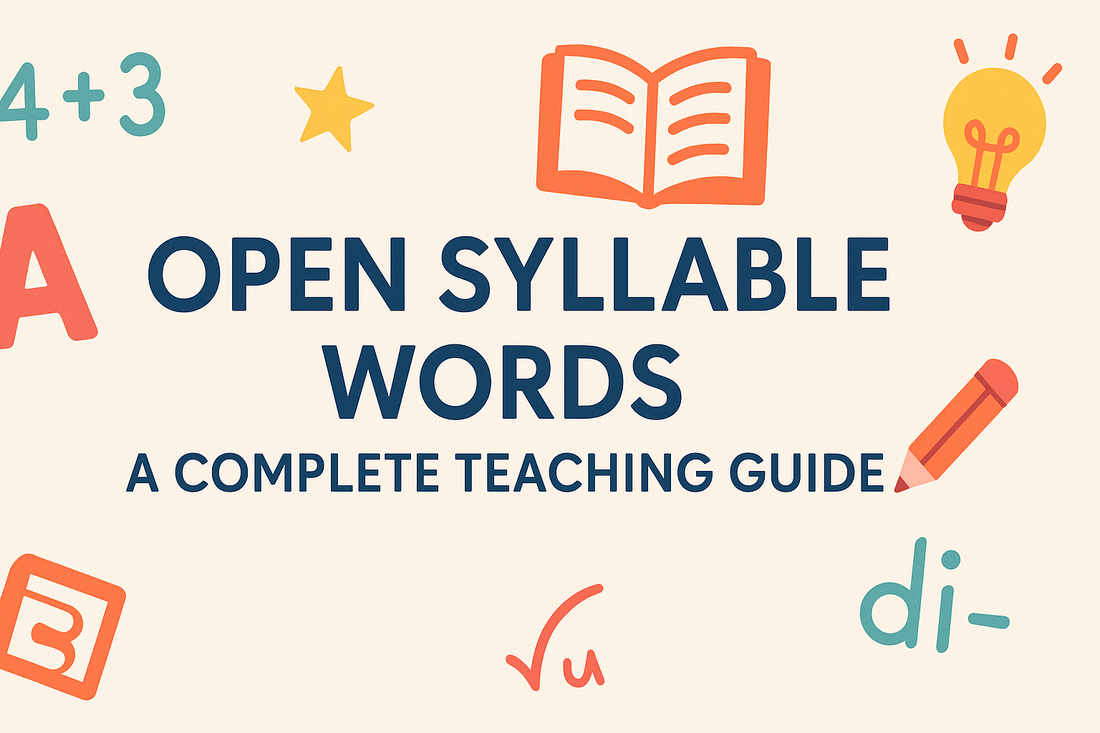What Are Open Syllable Words? Why They Matter More Than You Think
Open syllable words are one of the most overlooked—yet powerful—phonics patterns for building fluent readers. If you’ve ever seen a student pause at a word like go, she, or robot, you’ve likely witnessed the open syllable rule in action. And when kids don’t know the rule, they guess. They mumble. They substitute random words.
But when they do know it? They decode with confidence.
In this post, I’m going to break down exactly what open syllables are, how to teach them, why they matter so much in the early grades, and how to embed them in real reading practice using first grade decodable books and our full decodable book collection.
What Are Open Syllable Words? A Straightforward Definition
Let’s get clear on the definition.
An open syllable ends in a vowel and that vowel makes a long sound (its name). Unlike closed syllables, which end in a consonant and make a short vowel sound, open syllables are “open” because there’s no consonant closing them off.
Here are examples of open syllable words:
-
go
-
she
-
hi
-
me
-
we
And in two-syllable words:
-
robot (ro-bot)
-
tiger (ti-ger)
-
music (mu-sic)
-
hotel (ho-tel)
In each case, the first syllable is open, ending in a vowel that says its name.
Why Open Syllables Are Crucial for Early Readers
Open syllables appear in many high-frequency and tier-one vocabulary words. If students can’t decode them, they often default to guessing or misreading.
Here’s why teaching them early matters:
-
They appear in hundreds of early texts. Words like go, so, we, she, be, and me show up again and again.
-
They’re foundational to multisyllabic decoding. Kids who can’t read the open syllable in robot will struggle with similar words in later grades.
-
They break the short vowel assumption. Many students are taught early on that vowels make short sounds. Open syllables show them there’s more to the story.
Without explicitly teaching open syllables, we leave students with an incomplete—and often frustrating—view of how English really works.
The Science of Reading and Open Syllable Instruction
The science of reading emphasizes explicit, systematic instruction in phonics and syllable types. Open syllables are one of the six syllable types, and knowing them helps students decode longer, more complex words.
According to research-backed practices:
-
Syllable types should be introduced in isolation.
-
Instruction should involve modeling, repetition, and transfer.
-
Decodable text should be used to give immediate context and application.
When I teach open syllables, I focus on the structure first, then apply that knowledge in actual reading. That’s the difference between short-term memorization and real reading mastery.
How to Teach Open Syllable Words Effectively
Here’s the approach I use that works:
-
Start with VC (vowel-consonant) and V (vowel only) words.
Show kids the difference between go and got, or me and men. -
Use a mirror and mouth cues.
Have students say go and feel their mouths stay open at the end. Contrast that with got, where the mouth closes. -
Teach the concept of syllable splitting.
In robot, cover the second syllable and say the first. “Ro... it ends in a vowel. That’s open!” -
Use a consistent marking system.
Some teachers underline or circle vowels; others draw a box around syllables. Pick one, and stick with it. -
Practice in isolation, then in context.
Isolated practice helps with recognition. Contextual practice (like reading decodable books) ensures application.
Common Mistakes Kids Make—and How to Fix Them
If a child reads he as /hĕ/ or we as /wĕ/, they’re likely treating it like a closed syllable.
Fix it by:
-
Drawing attention to the final vowel and asking, “Is there a consonant after the vowel?”
-
Reinforcing the idea that vowels at the end are free to say their name.
-
Giving lots of paired examples: me/men, we/web, go/got, hi/hid.
Another mistake: skipping over the first syllable in multisyllabic words. Teach kids to break words at natural syllable boundaries and check each syllable type.
When to Teach Open Syllables in Your Scope and Sequence
I introduce open syllables after students have mastered:
-
CVC (closed syllable) words
-
Initial blends and digraphs
-
Magic e (CVCe words)
That way, they already have a solid understanding of short and long vowels. Then open syllables give them another strategy for decoding long vowel sounds—without needing a silent e.
You can also cycle back to open syllables repeatedly as students encounter new multisyllabic words.
Syllable Sorting and Hands-On Practice
Here’s one of my favorite classroom activities:
-
Write a bunch of short words on index cards: go, got, me, met, she, ship.
-
Ask students to sort them into two piles: open syllable (long vowel) and closed syllable (short vowel).
-
Discuss the pattern.
You can level up this activity by including two-syllable words, asking students to label each syllable as open or closed.
Hands-on activities like this help move the concept from abstract rule to concrete skill.
Using Decodable Books to Reinforce Open Syllables
Once students can identify open syllables in isolation, they need to see them in context. That’s where decodable books shine.
In our 1st grade decodable books, open syllables are embedded in short, engaging stories that reinforce the rule again and again. And in our complete decodable library, you can find leveled texts that align with whatever phonics pattern you’re teaching.
Repetition in context builds fluency—and it also gives kids the confidence to tackle bigger words without fear.
Final Thoughts: Why Open Syllables Deserve a Spotlight
We spend a lot of time on CVC words, magic e, and blends—and rightfully so. But open syllables are often brushed past too quickly. And when we rush, kids miss the structure. They resort to memorizing or guessing.
Don’t skip it. Don’t assume they’ll just figure it out.
Open syllables are simple, powerful, and game-changing when taught right.
So let’s give them the attention they deserve. Teach the pattern. Practice it. Reinforce it in context. And watch your students unlock a whole new layer of reading independence.
FAQs
1. What are open syllable words and how do they affect reading?
All the open syllable words consist of a final vowel, the vowel being free to deliver its lengthy sound as its name (since no final consonant is present). As a rule, the instruction of students instills accuracy, minimizes the use of guesswork, and fosters fluency because the children learn how to decode a large number of high-frequency and multisyllabic words satisfactorily.
2. How do open and closed syllables differ in English?
-
Closed syllables = the syllables on which a vowel is closed at the end by a consonant (cats, pen, hot).
-
Open syllables conclude with a vowel that pronounces its long sound (e.g., go, me, no, and in the multisyllabic word, robot, and tiger).
This realization is important in the student decoding new words correctly as well as becoming aware of English vowel patterns.
3. Why is it important to teach both open and closed syllables?
The instruction of both types of syllables can help students develop the full decoding tool kit. The closed syllables usually come first (e.g., CVC simple words). When children are able to figure out how to read open syllables, then they can easily read longer words by recognizing the type of syllables. With this systematic method, which is very well backed by organized literacy, there is a tendency to avoid the traps of misreading and guessing word patterns such as silent-e in words like hotel or baby. Beyond making corrections, accurate, fluent, and comprehensible reading acquires a boost as readers develop along the way.
4. How can teachers use open and closed syllable concepts in reading instruction?
The following are feasible evidence-based strategies:
-
Present in order: Teach closed syllables (CVC), then open syllables (e.g., go vs. got), and contrast them to explain the rule.
-
Syllable division: Differentiate between syllables by using such words as ro-bot, ho-tel, and ti-ger and have the students write down the different syllables.
-
Multisensory marking: use graphics--underline closed syllabic patterns, highlight open, accompany motions, or mark syllables through gestures.
-
Practical works: Encourage students to sort (open vs. closed), word surgery (syllable cut and label them), and syllable walk (syllable word card tour around the hall).

